
The traditional art of Chinese surface pattern
China is one of the pioneers in terms of textile production, the art of fabric has been present for centuries and centuries. Embroidery is a tradition dating back more than 2,000 years in China, particularly in the Miao culture, a Chinese ethnic group. Textiles are a real cultural base in China. Indeed, embroidery was once a means of communication used to tell legends and past events, thanks in particular to different surface patterns, or even a method to express feelings. Over time, weaving techniques and textile materials have evolved; silk has given way to the arrival of synthetic threads and textiles, which has led to changes in manufacturing processes. However, interest in traditional textile designs still seems to be in vogue.
The traditional Chinese pattern
In Chinese culture, pattern and textile are closely linked. More than a simple illustration, it is a true symbol, an art of living. Indeed, the three types of traditional pattern have literally spanned the ages.
Natural patterns that illustrate flowers or animals are omnipresent. Each pattern has a symbolic meaning. For example, the lotus represents purity, the phoenix is a symbol of immortality, and the dragon is associated with imperial power. Landscapes and nature scenes capture the beauty of the world and reflect the harmony sought by Chinese culture.
Geometric patterns, such as squares, circles and intersecting lines, are also common. They are often inspired by Chinese philosophies and religions. Mythology and folklore take a significant place in Chinese culture, and textiles are no exception to this rule. Indeed, we often observe mythological figures such as dragons and phoenixes on clothing and decorative fabrics. These creatures are symbols of various qualities such as wisdom, prosperity and benevolence. Historical and legendary scenes, told through textile patterns, also play a crucial role in transmitting cultural narratives and values.
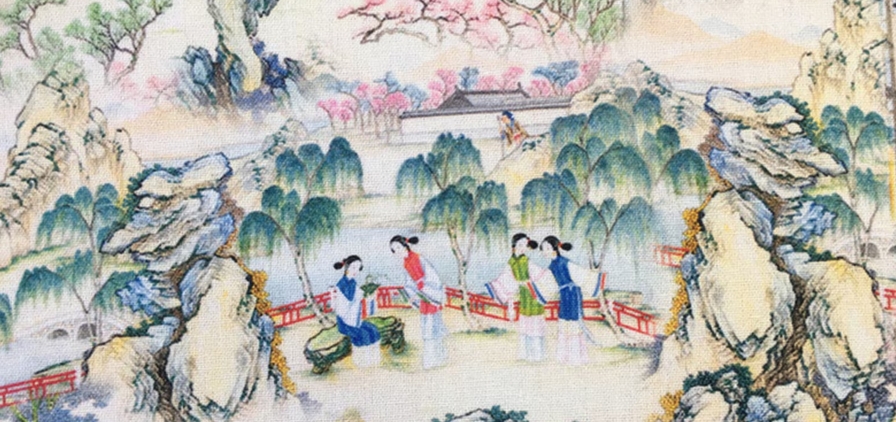
The particularities of Chinese patterns
Beyond a very singular and unique design, Chinese textile patterns have real cultural particularities. Firstly, the strong historical dimension of the latter. The designs' illustrations tell traditional legendary stories. Some designs are even specially designed to commemorate historical events or celebrate military victories. This is also why it is common to find a lot of fabrics with Chinese patterns in certain museums. Furthermore, certain dynasties, such as the Tang, Song, Ming and Qing, greatly influenced Chinese fashion and certain patterns of their respective centuries.
The second particularity of the Chinese textile surface pattern is found in the graphic style. Indeed, these patterns use bright and symbolic colors. In Chinese tradition, red is associated with luck, prosperity and celebration. Yellow/gold, which is widely used in China, is historically linked to the emperor and royalty, a symbol of power and wealth. Green, on the other hand, is used to represent nature, vitality and growth. However, the contrast of black and white is also relatively present, the latter symbolizes the famous Yin and Yang, the perfect balance.
Who is the textile pattern aimed at?
To enjoy the joys of Chinese design, rest assured, it is not necessary to participate in a traditional Chinese festival, quite the contrary! The Chinese textile pattern is certainly a cultural heritage but above all it is an unparalleled touch of style and refinement. Indeed, due to the elegance and fantasy of these surface patterns, the world of luxury and haute couture has seized on the Chinese textile pattern, to make clothes with refined and exotic touches with a thousand and one details, enough to delight the models on the catwalks!
However, Chinese textile patterns also adapt to everyday outfits thanks to their magnificent colors, in order to offer modern and elegant styles available at low prices!
If you are moving towards the traditional Chinese pattern, it is better to adhere to this pronounced style. Obviously, it is possible to move towards the creation of a fabric decorated with the mythical oriental dragon. Serpentine body, bearded mouth, no wings, the oriental dragon is different from the European dragon, as evidenced by the numerous illustrations in Japanese anime, whose aesthetics of the mythological animal is inspired by the patterns of their Asian neighbor from China, which differ from the terrifying animal that we can see in series like Game of Thrones. For another design, certain objects are essential, like the lantern or the fan. Clouds and flowers are also popular designs for decorating fabrics in China. But in a more abstract style, many geometric and symbolic designs are typical of Chinese decoration.
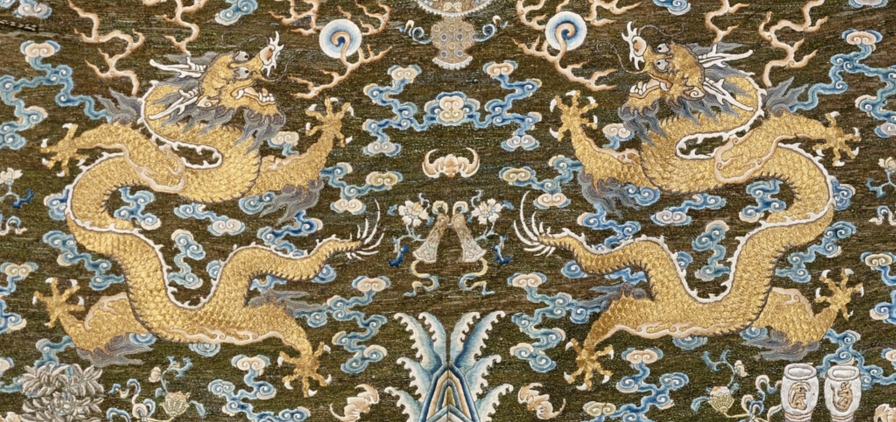
The main Chinese surface patterns
The oriental dragon pattern
This divine creature is an integral part of Chinese cultural history. Thus, dragon illustrations have appeared since the dawn of time in the Middle Kingdom to adorn fabrics, but also sculptures and traditional vases. The oriental dragon, with its very specific aesthetic style, perfectly represents traditional Chinese culture which mentions the sky as a superior entity, and therefore celestial creatures as deities. Like fairies and phoenixes, dragons are deified, and the Chinese attribute to them the ability to play on the weather by invoking wind and rain. Thus, the dragon is one of the positive symbols of Chinese culture, in the continuity of the luminous energy of Yang, conveying virtues such as good fortune, wealth and power.
The phoenix surface pattern
In Chinese culture, the phoenix has a very different representation from the mythological animal described in Western stories. Rather than the red bird which bursts into flames before being reborn from its ashes, the phoenix simply designates a majestic bird which appears during times of peace. Several illustrations of the Chinese phoenix are available on relics dating back centuries, but the most common design in crafts remains the version of the pheasant-like bird with peacock feathers. In China, the phoenix is referred to as the fenghuang, and in the writings of Taoism this superior being is depicted as the ancestor of all living bird species. A sign of the celestial divinity, like the dragon, we find the phoenix as an artistic decoration but also as a symbol of funeral rites, as evidenced by the jade fenghuang from the Shang dynasty which served as a funerary object to honor the memory of the deceased.
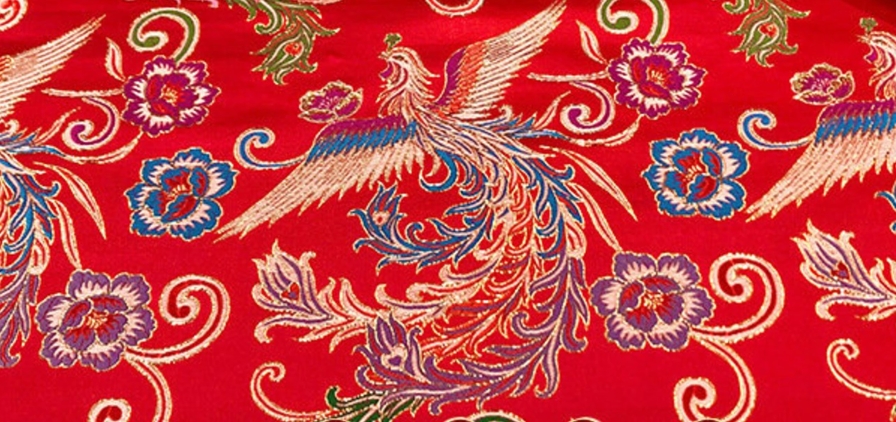
The cloud pattern
What better symbol to illustrate celestial power than the clouds? In traditional Chinese culture, beyond the sky lie divine realms, a representation that can be likened to celestial paradises. The clouds then mark the border between the earthly kingdom and the divine kingdom. They participate in the mysterious and mystical side of the divine worlds, serving as a natural veil leaving room for imagination. The style of the cloud drawings differs, but the original inspiration remains the seven-colored clouds from Chinese mythology to designate the arrival of the immortals. On a fabric or a vase model, dark red or immaculate white, illustrations of clouds span the ages to adorn art, crafts and fashion in China. There are also several symbols of clouds with lightning, a surface pattern announcing rain which represents abundant agricultural crops and therefore prosperity for the population.
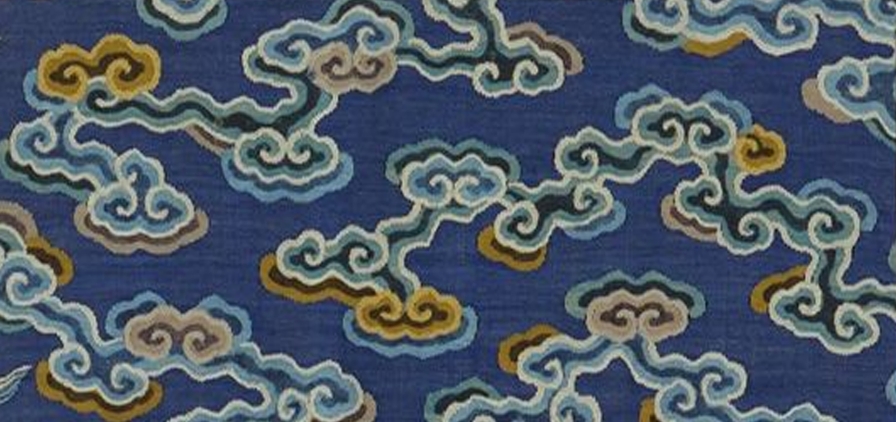
Table: Main Chinese Motifs
|
Motif |
Origin / Nature |
Main Symbolism |
Visual Representation |
Traditional Use |
|---|---|---|---|---|
|
Oriental Dragon |
Divine creature present since Antiquity in Chinese culture |
Good fortune, wealth, power, Yang energy; ability to influence weather (wind, rain) |
Distinctive Eastern dragon aesthetics, celestial creature |
Textiles, sculptures, vases |
|
Phoenix (fenghuang) |
Majestic bird, ancestor of all bird species according to Taoism |
Appears during times of peace; symbol of celestial divinity |
Bird resembling a pheasant with peacock feathers |
Decorative arts, funerary symbols (e.g., jade, Shang dynasty) |
|
Clouds |
Celestial symbol associated with divine realms |
Boundary between the earthly world and divine realm; mystery, immortality, prosperity (rain, abundance) |
Stylized clouds, sometimes with lightning; inspired by seven-colored clouds |
Textiles, vases, Chinese art and fashion |
How to wear the Chinese textile pattern?
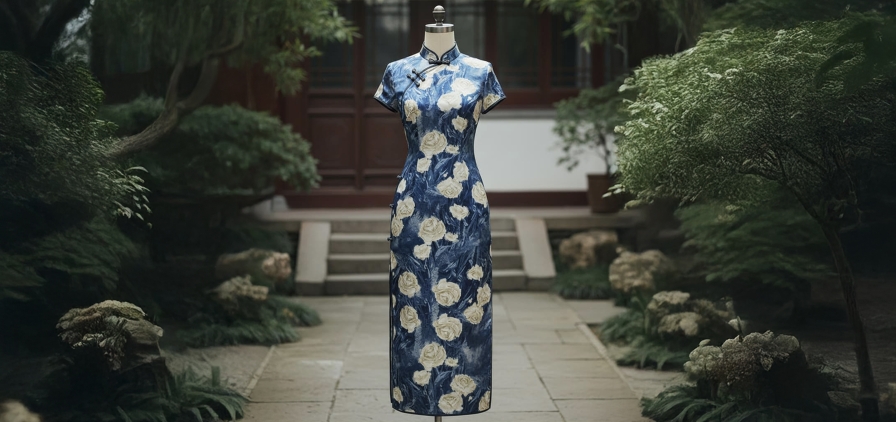
Chinese textile designs are used in a wide variety of different clothing, from traditional silk outfits to modern designs. For those who want to wear these Chinese designs in a traditional way, the Qipao is an interesting option. This is a traditional Chinese dress, fitted with a silk collar and slit on the sides. Common designs with this type of clothing are usually dragon illustrations, flowers, clouds or fan designs. We find these fabrics in a traditional mandarin red, but the opening towards more contemporary pieces allows these dresses to be available in white, beige or pink, or even black for the most modern models. In the men's version this time, the Changshan is a long masculine dress with a straight collar, the main surface pattern of which remains the oriental dragon in its very characteristic style, with an elongated shape, without wings but with legs with sharp claws, and whiskers on the muzzle.
Furthermore, for those who wish to combine tradition and modernity, the Chinese textile pattern adapts perfectly to any garment with any type of fabric. Like African wax seamless pattern , which are generally sold as fabric but can be used on a wide variety of items, Chinese prints can be used to decorate a wide range of clothing items. For example, the Chinese surface pattern is the perfect print to dress up a blouse or blouse with a floral pattern for your summer. In another style, you can dress your accessories, like scarves or scarves, with abstract surface patterns or animal patterns .




















